The modern Atlético Madrid has long been defined by edge and energy. Into that furnace has stepped Giuliano Simeone, a forward forged by the game’s small margins and life’s hard knocks. Born in Rome, educated in Buenos Aires and Madrid, and tempered by a brutal leg fracture before his first full La Liga season, he has returned not as a story of nepotism, but as a study in persistence. By 2024–25 he was scoring in La Liga and Europe for Atleti, adding a first senior cap (and goal) for Argentina and renewing the idea that hunger and humility still travel in the same boots.
The Genesis Of A Forward: Early Life And Family
Every striker is built long before the first professional goal. With Giuliano Simeone Baldini, that construction began at home-where dinner-table conversation mixed tactics, training, and the quiet rituals of competition. To understand his game, you first trace the people, places, and habits that gave it shape.
Family roots and a house that spoke football
Giuliano is the youngest footballing son of Diego Pablo Simeone, Atlético Madrid’s head coach, and Carolina Baldini, a former handball international whose discipline and athletic habits were a daily example. The family’s sporting DNA runs in parallel lines: a father who preached intensity and collective responsibility; a mother who modeled preparation, recovery, and respect for routine.
Two older brothers paved visible pathways. Giovanni took the hard road through Argentina and Italy to become a Serie A and Argentina international; Gianluca worked the margins of the professional game as a forward in Spain’s lower leagues. Between them, Giuliano saw both extremes: the spotlight and the grind. That contrast taught him an early lesson-talent opens the door, but repetition keeps you inside.
Birthplace, identity, and the choice of flag
Born December 18, 2002, in Rome, Giuliano grew up with Argentine roots and Italian birthright. That dual identity wasn’t a branding line-it shaped the footballer. Italy’s school of detail and tactical organization met Argentina’s culture of street smarts and individual resolve. When national pathways emerged, choosing Argentina felt less like rejecting Italy and more like returning to the language of the family’s football-pressing with conviction, competing with edge, and wearing the shirt as duty, not costume.
A competitive household without shortcuts
Life at the Simeone home did not romanticize sport. There were early alarms, shared runs, and unglamorous drills. If Diego spoke often of “suffering well,” Carolina made sure that meant planned suffering-nutrition, sleep, and physio, not just slogans. Giuliano absorbed both: the mentality to work when nobody watches and the structure to make that work count.
He also learned the value of earning minutes. When you share a surname with a famous coach, every touch is judged twice. The family answer was simple-let performance neutralize noise. That mindset would follow him from youth teams to senior dressing rooms.
From River To Madrid: The Making Of Habits
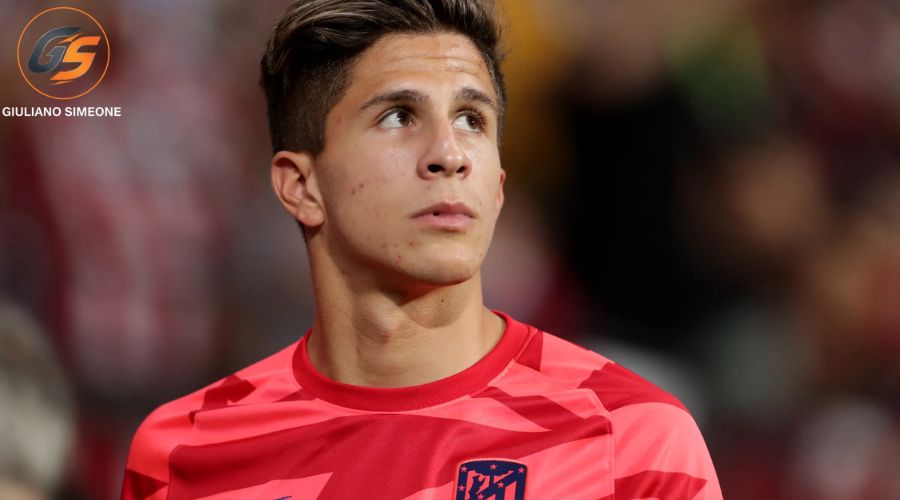
Moving from a surname to a skill set required hours on training grounds and thousands of small touches. River Plate refined his technique; Atlético Madrid hardened his edges. Together, they formed the two pillars of his profile.
River Plate: technique in tight spaces
Before Madrid’s red-and-white became a uniform, River Plate became a school. At River, training lives in congestion-tight touches, fast decisions, small-sided superiority. Giuliano learned to play in traffic: cushioning first touches into space, trimming the backlift on finishes, and attacking near-post seams with minimal tells. Coaches demanded the ball arrive quickly and leave even quicker.
This phase gave him habits, not highlights: checking shoulders before receiving, creating blind-side angles, and learning when to sprint and when to drift. It also gave him an instinct for box craft-arriving late at the back post, disguising near-post darts, and riding the line to stay onside without wasting steps.
Atlético Madrid academy: pressing as principle
The 2019 move to Atlético Madrid’s academy layered a second identity on top of the River base: pressing as theology, sacrifice as first principle. Sessions began with shape and ended with structure. Angles mattered, distances mattered, and so did the recoveries after a lost duel. You didn’t just “run hard”-you ran with purpose, on a trigger, in a chain.
Within that system, Giuliano learned to become a finisher from wide rather than a conventional crossing winger. He attacked the channel between fullback and center-back, arrived late on cut-backs, and made curved runs that pulled the last line apart. The numbers followed the habits: 29 goals in 51 league appearances for Atlético B inside two seasons-evidence that timing and repetition were outpacing surname narratives.
The bridge years: learning to be useful every minute
Between youth football and the professional game lies a narrow bridge where many prospects stall. Giuliano crossed it by adding utility to talent. He became comfortable in three roles:
- as a right-sided forward pressing on the defender’s first heavy touch,
- as a second striker linking one-touch walls with the 10,
- and as a No. 9 attacking the front post on early balls and finishing across the keeper.
Coaches value players who solve problems at match speed. Giuliano’s edge was not trickery; it was repeatable actions: a first touch that points to goal, a second that creates the angle, and a third that ends the conversation.
Personal information
| Full name | Giuliano Simeone |
| Date of birth | 18 December 2002 |
| Place of birth | Rome, Italy |
| Height | 1.75 m (5 ft 9 in) |
| Position | Forward / Winger |
Team information
| Current team | Atlético Madrid |
| Number | 20 |
Senior career*
| Years | Team | Apps (Gls) |
| 2021 – 2022 | Atlético Madrid B | 27 (6) |
| 2022 – 2023 | Atlético Madrid | 1 (0) |
| 2022 – 2023 | → Real Zaragoza (loan) | 36 (9) |
| 2023 – 2024 | → Deportivo Alavés (loan) | 20 (3) |
| 2024 – | Atlético Madrid | — (—) |
International career‡
| 2015–2016 | Republic of Ireland U17 | 6 | (2) |
| 2016–2017 | Republic of Ireland U19 | 6 | (0) |
| 2017–2018 | Republic of Ireland U21 | 5 | (0) |
| 2018 | Republic of Ireland | 3 | (0) |
| 2019– | England | 70 | (6) |
Values that travel: what the upbringing still does for him

A player carries his home into every dressing room. In Giuliano’s case, three values survived every move-from Rome to Buenos Aires to Madrid-and still define his football.
Accountability over alibis
The Simeone vocabulary places responsibility ahead of excuses. Missed chances are reviewed, not rationalized. He learned to analyze movements rather than simply mourn outcomes-did the run start too early, was the angle wrong, did the first touch close the finish? That habit of self-audit explains why his off-ball work keeps improving.
Team above title
Growing up with a coach for a father and professionals for siblings drilled one mantra: the team’s need determines your role. If the match asks for decoy runs, you run. If it asks for a back-to-goal pivot, you hold. That’s why, even when listed as a winger, he plays like a striker who understands midfield pictures.
Endurance as a skill
Finally, the family lesson no metrics fully capture: stay present. Across youth moves, academy battles, and the scrutiny that comes with his surname, Giuliano kept turning up-same intensity, same routes, same repetitions. Endurance isn’t just lungs; it’s consistency of intent.
A player carries his home into every dressing room. In Giuliano’s case, three values survived every move-from Rome to Buenos Aires to Madrid-and still define his football.
Accountability over alibis
The Simeone vocabulary places responsibility ahead of excuses. Missed chances are reviewed, not rationalized. He learned to analyze movements rather than simply mourn outcomes-did the run start too early, was the angle wrong, did the first touch close the finish? That habit of self-audit explains why his off-ball work keeps improving.
Team above title
Growing up with a coach for a father and professionals for siblings drilled one mantra: the team’s need determines your role. If the match asks for decoy runs, you run. If it asks for a back-to-goal pivot, you hold. That’s why, even when listed as a winger, he plays like a striker who understands midfield pictures.
Endurance as a skill
Finally, the family lesson no metrics fully capture: stay present. Across youth moves, academy battles, and the scrutiny that comes with his surname, Giuliano kept turning up-same intensity, same routes, same repetitions. Endurance isn’t just lungs; it’s consistency of intent.
The Unveiling Of Talent: Zaragoza, Alavés, And A Broken Leg
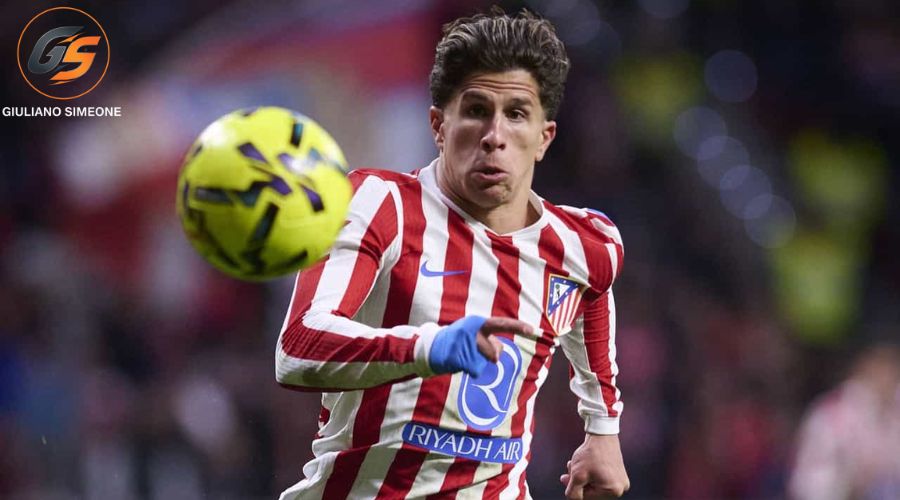
The jump from academy promise to senior football is where ideas meet impact. For Giuliano Simeone, this phase arrived in two sharp chapters: a year of hard lessons and end-product at Zaragoza, followed by a cruel injury at Alavés that reframed his priorities without dimming his purpose. To understand the forward he is becoming, it helps to walk through both doors-how he learned to compete with veterans, and how he learned to start again.
Zaragoza – learning the adult game
Before the numbers, there was the education. Loaned to Real Zaragoza for the 2022–23 campaign, Giuliano discovered a league that demands economy of touch and honesty of movement. Segunda is unforgiving to young forwards who wait for the game to find them; he had to go and get it. Over 36 league matches he scored 9 goals, but the real growth lived in the spaces between actions: the body-shape to receive under pressure, the timing of diagonal runs, the first touch that points the second.
Coaches at La Romareda asked him to toggle between roles-sometimes a narrow right forward attacking the inside channel, sometimes a second striker pinning a center-back to free the No.10. His pressing became more purposeful: he learned to sprint on cues (a loose first touch, a square pass across the back line) rather than chase for optics. In transition he added a valuable habit for a smaller forward-arrive rather than hover-curving runs to the back post and attacking cut-backs instead of waiting central with defenders square to him.
The goals told a modest but meaningful story. Several were “first-post” finishes hit early, before the goalkeeper could set; others came from late arrivals where the cut-back met his stride rather than his heels. He also banked the invisible reps: shielding long clearances to buy territory, drawing fouls to reset a tired block, and playing one-touch layoffs that invited midfielders to climb the pitch. By spring, Zaragoza trusted him in tight-score states not only to finish, but to stabilize possessions-adult football’s most underrated currency for a young attacker.
Alavés – the fracture that paused a career, not a mindset
Progress earned a reward. In July 2023, Atlético extended Giuliano’s deal through 2028 and sent him on loan to Deportivo Alavés for top-flight minutes. The plan was elegant: Primera defenders, real pace, real stakes. Then football reminded everyone that plans are theories. Eight days into August, in a friendly against Burgos, a reckless challenge shattered his left fibula and damaged his ankle. Sirens, shock, silence. The loan’s logic suddenly felt cruelly hypothetical.
The diagnosis was blunt: a serious leg-and-ankle injury with a timeline measured in patience. The season that was supposed to launch him would now teach him something else entirely-how to be a professional when you can’t play. Where Zaragoza had toughened his game, Alavés would toughen his calendar.
The autumn of rehab – rebuilding from the ground up
Injury recovery is its own league, with daily fixtures against boredom, doubt, and the deceptive optimism of a “good day.” Giuliano entered the slow grammar of rehab: inflammation management, range-of-motion work, then the lonely repetitions that rebuild trust-calf raises to wake the chain, band walks for hip stability, isometric holds to remind the ankle it can carry force. He learned to celebrate unglamorous milestones: two crutches to one, the first unaided step, the first stationary bike session where sweat meant progress, not panic.
The return-to-run phase demanded restraint. Straight-line jogs became controlled accelerations; grass felt like a privilege. Strength coaches layered in deceleration drills (stop on command, not on pain) and change-of-direction patterns that mimicked the football he would eventually play: plant on the recovering side, push away, repeat. A final checkpoint-ball work at game angles-restored the feedback loop between touch and trust. Throughout, he kept film study close: patterns of movement he could rehearse mentally when the body couldn’t yet comply.
What the two chapters changed – habits, edges, and perspective
The Zaragoza season had taught Giuliano to think like a senior forward; the Alavés injury taught him to live like one. Together they left practical upgrades. In the box, he became even more deliberate about run profiles: if the near-post lane closes, delay the sprint and attack the seam between fullback and center-back; if the wide player is shaping to cross early, start a half-step deeper to meet the ball on the move rather than flat-footed. Out of possession, his pressing cadence improved-shorter, sharper bursts that funnel play rather than heroic but wasteful chases.
But the biggest change was composure. The rehab winter taught him patience that travels: an extra beat before shooting, a calmer first touch when the ball skids, a willingness to recycle instead of forcing a low-percentage strike. He re-entered competition with a striker’s instincts and a midfielder’s respect for possession-useful in any system, essential in Atlético’s.
The takeaway – a career re-centered, not derailed
Some loans give you minutes; this one gave him meaning. Zaragoza provided the proof that he could manufacture chances against men; Alavés provided the proof that he could manufacture resolve when football withheld the ball. The fractured leg paused a season, not a mindset. And when he stepped back into red and white, the runs were cleaner, the pressing smarter, and the finishes touched by a confidence you can’t fake-the kind you earn in gyms at 8 a.m., counting reps no camera records.
The Atlético Return: Goals, Europe, And A Shirt That Fits

By the summer of 2024–25, Giuliano Simeone slipped back into Atlético Madrid life with a different rhythm-stronger through the core, cleaner on his first touch, and more economical in how he covered space. The months of rehab had sanded down excesses and left a forward who wasted neither movement nor moments.
Firsts In Red And White
Before the goals, there was a feeling: he now arrived to spaces instead of chasing them. That subtle shift framed a run of “firsts” that recalibrated his status within the squad.
On November 3, 2024, he scored his first goal for Atlético’s first team in a 2–0 win over Las Palmas-a finish that owed more to cold nerve than pyrotechnics. Winter then widened the stage: on January 29, 2025, he netted his first UEFA Champions League goal and added an assist in a 4–1 away victory, the sort of performance that proves timing and tempo still translate when the air thins at European altitude.
Knockouts And Nights Of Validation
Cup football compresses judgment; one evening can hard-bake a narrative. Arriving into February, Simeone found the kind of night players bank for years.
On February 4, 2025, he scored twice in a 5–0 Copa del Rey quarterfinal against Getafe-eight minutes to open, nine to repeat. The brace didn’t just carry Atleti to the semis; it released a collective exhale from terraces and touchline alike, a roar that sounded as much like relief as celebration.
A New Season, A Different Status
Preseason usually whispers; this one spoke up inside the first seven minutes. After the reset of summer, Simeone again underlined his utility with an early opener away to Alavés in late August 2025, reinforcing the idea that he now finds chances rather than hunts them. The match finished 1–1 and the campaign felt jittery, but his timing-of runs, of touches, of moments-looked right.
The Black-And-Sky-Blue Thread: International Pathway With Argentina
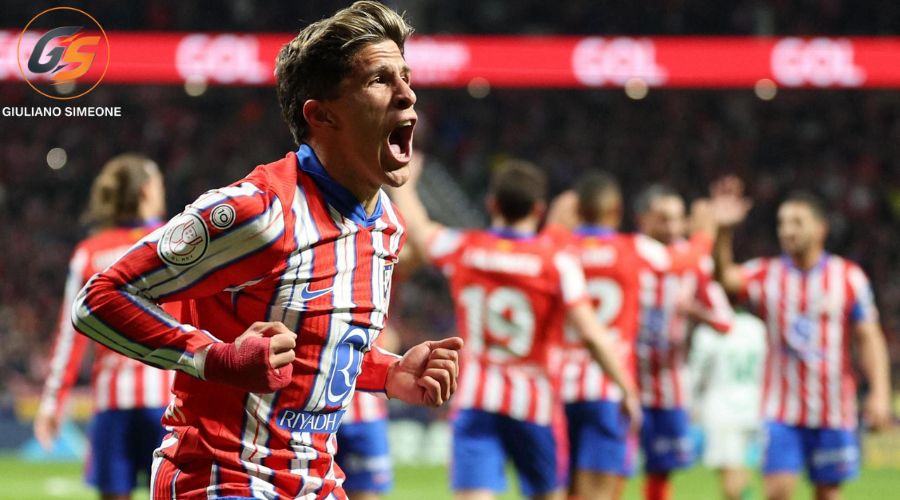
Born in Rome but raised in a footballing culture that thinks in celeste and white, Giuliano’s international arc always curved toward Argentina. What changed in 2024–25 wasn’t direction, but velocity.
Youth Ladder And Olympic Cycle
The first calls came with the Argentina U23s, where he learned the different grammar of international football-shorter windows to impress, longer stretches without rhythm. The Olympic cycle added tournament cadence and travel fatigue to his education, shaping a player who could compress impact into limited minutes and carry pressing habits across systems.
Senior Breakthrough And First Goal
Opportunity arrived as form and fitness aligned. During the 2026 World Cup qualifying window, Simeone earned his senior debut and opened his international goal account, a payoff for repetition rather than reputation. The cameo profile suited him: hit the press trigger, attack the near-post lane, and be decisive in one or two possessions instead of twelve.
Role Fit In The Albiceleste
With Argentina’s frontline stacked with star gravity and variety, Giuliano’s niche is clarity. He offers the staff a runner-finisher who can start wide, slide into the half-space, and end sequences in the six-yard box. In a team that manufactures superiority through rotations, his value is to arrive at the right second-not just to appear.
The Path To Impact: Role, Tools, And Tendencies
Simeone is not a highlights merchant; he’s a collector of micro-wins. Think half-yard bursts, angles that keep him onside, first touches that point him toward the target. That toolkit scales well at Atlético, where every sprint is an argument and every touch must add value.
Movement And Pressing Cues
Before the ball, there is the trigger. In Atlético’s structure, Giuliano reads the center-back’s second touch or a full-back receiving on the back foot as his call to jump. He doesn’t chase shadows-he jumps lanes, taking the shortest path to interfere with the next pass. This creates turnovers that look accidental but are designed: he’s attacking the pass, not the player.
Actions In The Box
Inside the penalty area, his craft is about separation. He favors curved, blind-side runs that start outside the defender’s eyeline and end across the front post. Against a late, stepping line he is notably good at holding his run a fraction longer, which turns tight offsides into onside finishes. Many of his chances are born from cut-backs and second balls because he arrives, rather than stands, in those zones.
Link Play And Combinations
Simeone understands when to empty a space rather than ask for it. His combinations are simple by design-one-touch walls, inside-out layoffs, and bounce passes that set the No.10 or overlapping full-back. He rarely overdribbles; if the next action isn’t vertical, he resets quickly to re-press.
Finishing Profile And Development
Right-footed and around 1.73 m, he is calmer on low, across-goal finishes than on high-near-post hits, though recent training blocks show rising confidence in near-post power. In transition, he prefers one setup touch; in set defense, he often opts for first-time contact to beat recovery angles. His shot map clusters at the back post and penalty-spot lane, reflecting his habit of arriving late to the cut-back corridor.
Physical And Mental Toolkit In The Atlético Ecosystem
Acceleration that reads louder in the last eight meters than the first eight makes him dangerous in short bursts-sprints that turn a half-chance into a shot. Mentally, he plays with economy: few gestures, few wasted touches, an insistence on repeatable actions. On roster sheets he may appear as a winger, but in practice his value is as a finisher from wide-a player who starts outside to arrive inside at speed.
Accolades, Milestones, And The Timeline That Matters

Giuliano Simeone’s CV is still being written, but the landmarks already sketch a player shaped by adversity, repetition, and timely breakthroughs. Below is a fuller, context-rich chronology that shows not just what happened, but why each step mattered.
2022–23: Real Zaragoza – First Full Season, First Grown-Man Numbers
Before a young forward can belong to a top-flight dressing room, he has to prove he can make chances repeatable against hardened, tactical back lines. That was Giuliano’s apprenticeship at Real Zaragoza.
Across the 2022–23 campaign he logged 36 league appearances and 9 goals, learning how to live without service, how to press without fouling, and how to arrive-rather than wander-inside the box. The goals weren’t padded by penalties or set-piece scraps; most were born from curved runs off a center-back’s shoulder, or from back-post darts after the far-side winger triggered a cut-back. By spring, he had evolved from “lively loanee” to “dependable finisher,” the kind of forward coaches trust to execute patterns rather than improvise them.
July 2023: New Atlético Deal To 2028 – Investment Meets Expectation
Big clubs don’t add years lightly. When Atlético Madrid renewed Giuliano through 2028, they weren’t rewarding a surname-they were ring-fencing a profile: a high-motor, multi-role attacker who presses on time and finishes across goal. The extension also framed the next step pragmatically: a loan in which minutes-not marketing-would decide his ceiling.
August 2023: Alavés Loan And The Burgos Friendly – The Fracture That Rewrote The Year
A week into pre-season with Deportivo Alavés, a tackle in a friendly vs Burgos brought a brutal reality check: left fibula fracture with ankle damage. For a young forward, the fear isn’t just pain; it’s the lost rhythm-those thousands of micro-reps that make timing unconscious. Rehab became a second job: ankle mobility, hip strength, first-touch retraining, and re-learning acceleration mechanics. The layoff extended into winter, but so did the lessons: economy of movement, smarter pressing angles, and the humility to accept that progress is non-linear.
November 3, 2024: First Atlético Goal – A Finish That Belonged
Back in red-and-white, Giuliano’s first Atlético goal arrived against Las Palmas on November 3, 2024-not a thunderbolt, but the kind of calm, across-the-keeper finish that says a player understands the box. Watch it again and you’ll see the details coaches crave: the hesitating check to hold the line, the touch that sets the ball out of his feet, and the shot early enough to beat the recovery tackle. It wasn’t just a number; it was proof he could translate training patterns to La Liga pace.
January 29, 2025: First Champions League Goal (Plus An Assist) – European Tempo, Same Composure
Europe doesn’t forgive loose touches. On January 29, 2025, Giuliano scored his first UEFA Champions League goal and added an assist in a 4–1 away win, passing his hardest exam yet: can you keep your decisions clean when the press is half a second quicker? His movement was textbook-start wide, bend the run inside the full-back’s blind spot, then finish into the far corner. The assist was as valuable: a one-touch wall pass that turned a half-chance into a high-value shot. It read like a manifesto for his role at the top level: efficient, repeatable, ruthless.
February 4, 2025: Copa Del Rey Quarterfinal Brace – Eight Minutes, Two Knives
Cup nights harden reputations. In the Copa del Rey quarterfinal on February 4, 2025, Giuliano scored twice against Getafe inside nine minutes, effectively ending the tie before it could develop bite. The first was a near-post sprint that punished a flat back line; the second, a back-post arrival that showed his habit of attacking the far stick when the opposite winger shapes to cross. A brace in a knockout game isn’t just output-it’s evidence you recognize moments and punish them.
August 30, 2025: Opening Day Statement At Mendizorroza – Timing As A Language
You never forget the first league goal of a season-especially when it comes inside seven minutes away to Alavés on August 30, 2025. For Giuliano, scoring against the team that hosted his darkest injury chapter closed a loop. The run was subtle (hold, hold, explode), the finish was firm, and the celebration was quiet. It said: I belong, and I’m present. Even as the match finished 1–1, the tape showed a forward who now arrives more than he chases.
2024–25: Senior Argentina Debut And First International Goal – From Prospect To Option
International football is a different oxygen level-less time, more consequence. During 2024–25, Giuliano earned his senior Argentina debut and scored his first international goal in CONMEBOL World Cup qualifying. The mechanics looked familiar: compact movements, selfless pressing, and a finish guided rather than forced. With that strike, he moved from “interesting pool player” to “selectable option” for competitive windows-an upgrade that reflects trust as much as talent.
Contract, Market Value, And The Business Of Belief

The shape of a young forward’s career isn’t just written on the pitch; it’s written in the paperwork that frames his growth. Giuliano Simeone’s deal tells you what Atlético think he can become and how they plan to get him there.
The 2023 Renewal: A Long Horizon
Signed in July 2023 and running through June 2028, the extension was less about headlines and more about runway. It locked in a prime-development window (ages 20–25), insulated the club against opportunistic bids, and gave the player clarity: a stable home base, elite coaching, and European minutes to stack year over year.
Market Value And The Role Of Versatility
Valuation models that blend age curves, position, and usage cluster him in the €30–35m bracket. The driver isn’t just goals; it’s role elasticity. He can work as a right-sided forward, second striker, or narrow winger, which lifts his utility across different game states-protect a lead, chase a deficit, or press from the front. In a squad engineered for modularity, that flexibility is a multiplier.
Minutes, Milestones, And Incentives
The contract only makes sense if minutes climb. The plan from 2024 to 2026 is simple: raise his baseline workload across La Liga, domestic cups, and Europe while tying tangible progress to internal milestones-chance creation, high-intensity runs, and pressing efficiency in the final third. Appearance triggers, collective bonuses, and continental progression incentives align his paycheck with team outcomes.
What The Deal Signals For Atlético
For the club, the message is cultural as much as financial: development is an investment, not a bet. Extending through 2028 safeguards resale value, but more importantly, it declares intent-Giuliano isn’t just depth; he’s a project with a defined role arc, measured not in viral clips but in repeatable contributions.
A Glimpse Behind The Pad: Personal Life And Family
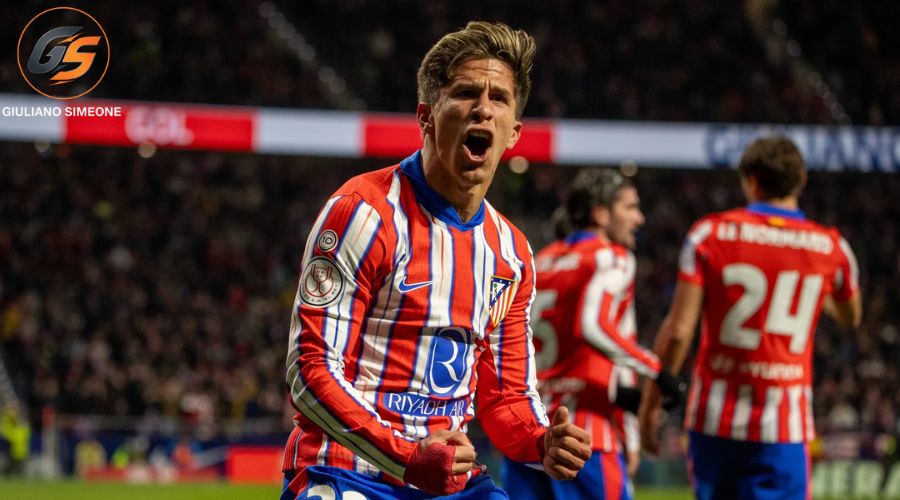
Football explains a lot about Giuliano Simeone, but not everything. To understand the cadence of his days-the rhythm behind the running-you look at the life around the game.
Living Ordinary Days In An Extraordinary Context
In Madrid, his routine is textbook: training, recovery, video, sleep. There’s comfort in repetition, a quiet professionalism that keeps noise out and patterns in. He lives like most pros do-nutritional discipline, soft-tissue care, and downtime that looks more like headphones and film than flash and cameras.
A Family Tree Written In Football
The surname is a megaphone and a mirror. Giovanni has made a Serie A life of ruthless penalty-box craft; Gianluca has worked the game’s harder margins; Diego is one of Europe’s longest-tenured managers. That lineage brings both scaffolding and scrutiny. Where some see shortcuts, he sees standards-arrive early, compete honestly, and leave excuses at the door.
Identity, Expectations, And Being “Just Giuliano”
The job, ultimately, is to be himself. That means taking the surname’s expectations and converting them into habits rather than theater. Less mythology, more Monday. Less inheritance, more hours. It’s a posture that keeps him centered: learn quickly, fail quietly, move forward.
The Player Beyond The Numbers: Why Simeone Matters Now
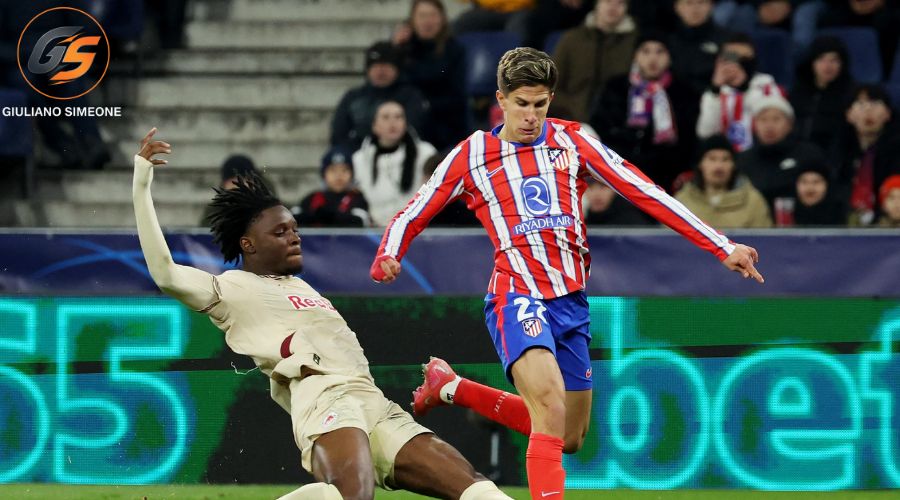
Numbers are helpful; they aren’t the whole story. What keeps Giuliano in lineups is not a single skill but a cluster of actions coaches can trust every week.
Repeatable Actions In Simeone-Ball
He offers the things staff can script: press the fullback’s first touch, sprint the near post on low crosses, angle the diagonal run to free the No.10, finish across the keeper instead of through him. None of it is glamorous. All of it moves scorelines in one-goal games.
Pressing DNA And National-Team Utility Toward 2026
As Argentina refresh their depth chart toward 2026, he fits as a runner who can initiate the press and arrive to score. Coaches get a forward who closes passing lanes without fouling, recovers into shape after the press is broken, and still has the discipline to hit box zones on time. It’s a plug-and-play profile for tournament football.
Resilience As A Performance Skill
The leg fracture that halted his first La Liga push didn’t just test fitness; it reorganized priorities. He returned with cleaner movement patterns, sharper economy, and an appreciation for the boring reps that keep careers alive-pre-hab, angles, and choices. That resilience isn’t a footnote; it’s a feature that shows up every time the match tilts toward chaos.
Giuliano Simeone’s story is not the parable of a famous father-it’s the ledger of a forward who keeps turning up. The Zaragoza season gave him repetitions; the Alavés fracture gave him perspective; the Atlético months gave him proof. What remains is the long work of building a career whose peaks are about more than surname.
If you want to understand where he’s going, replay the goals from Las Palmas and Salzburg, the Copa del Rey brace, and the sprint at Mendizorroza in August 2025. There’s a pattern: decisive movement, efficient touch, and the quiet certainty of a player who has already survived the hardest part-still believing when the leg won’t.


